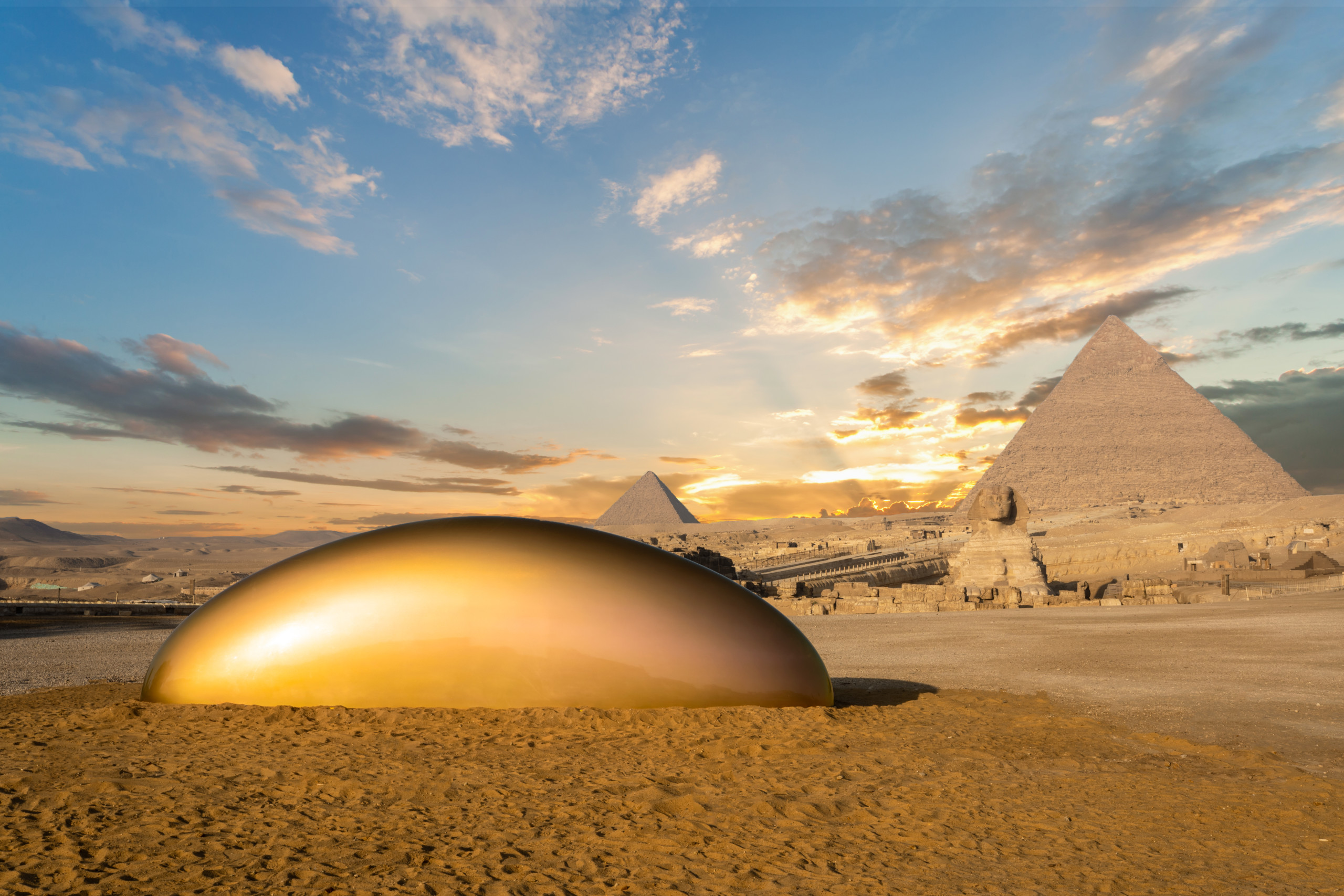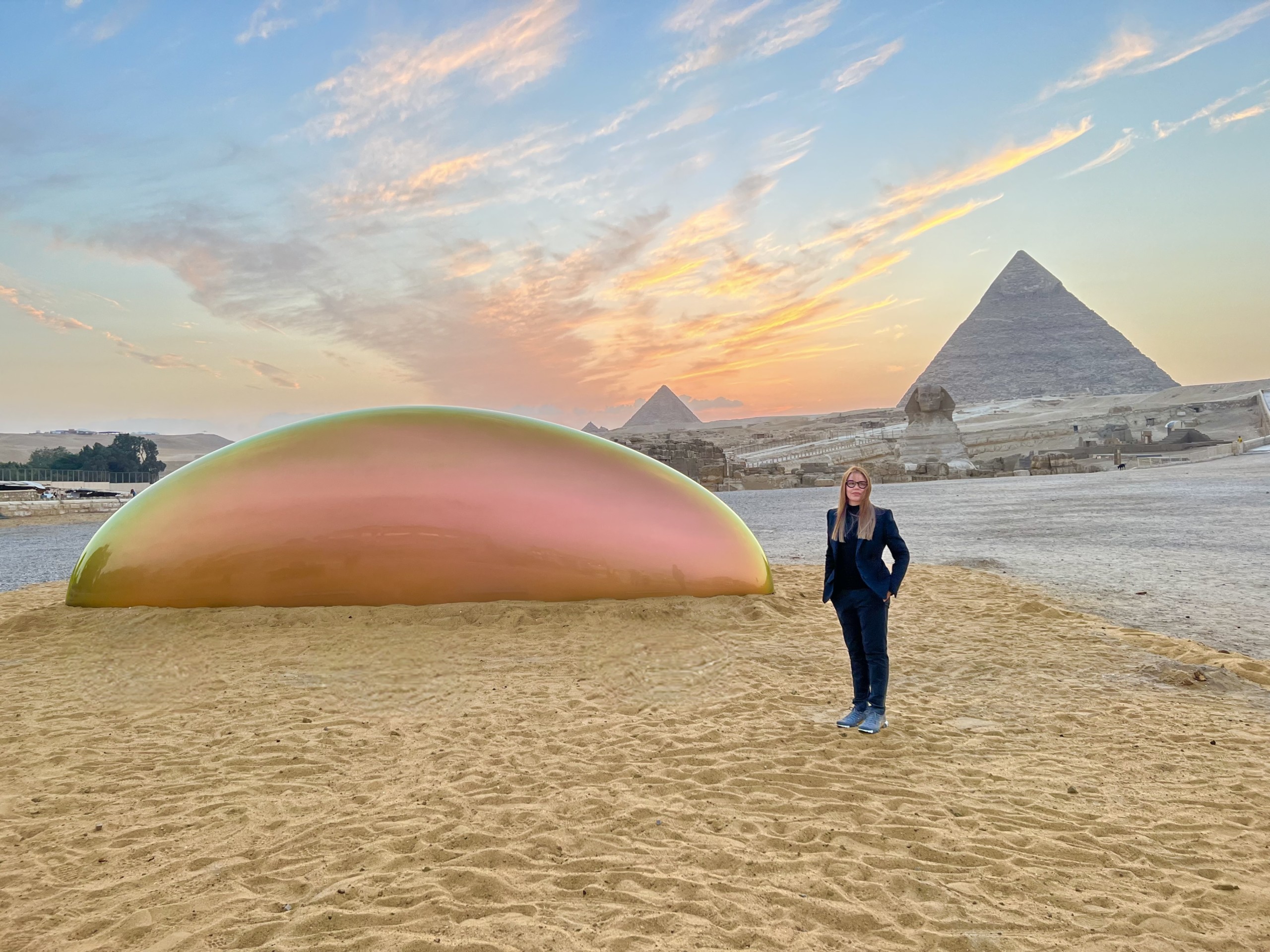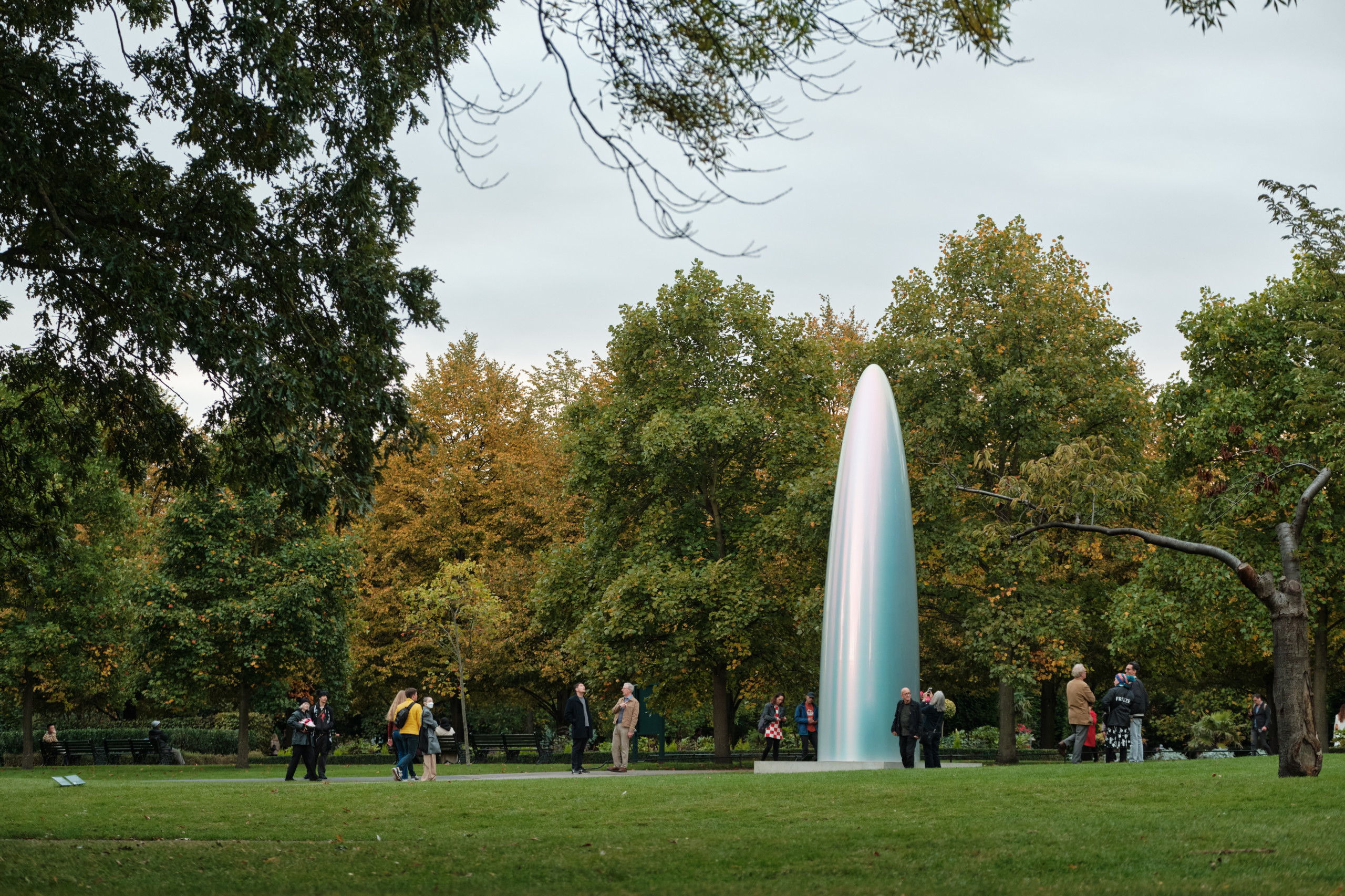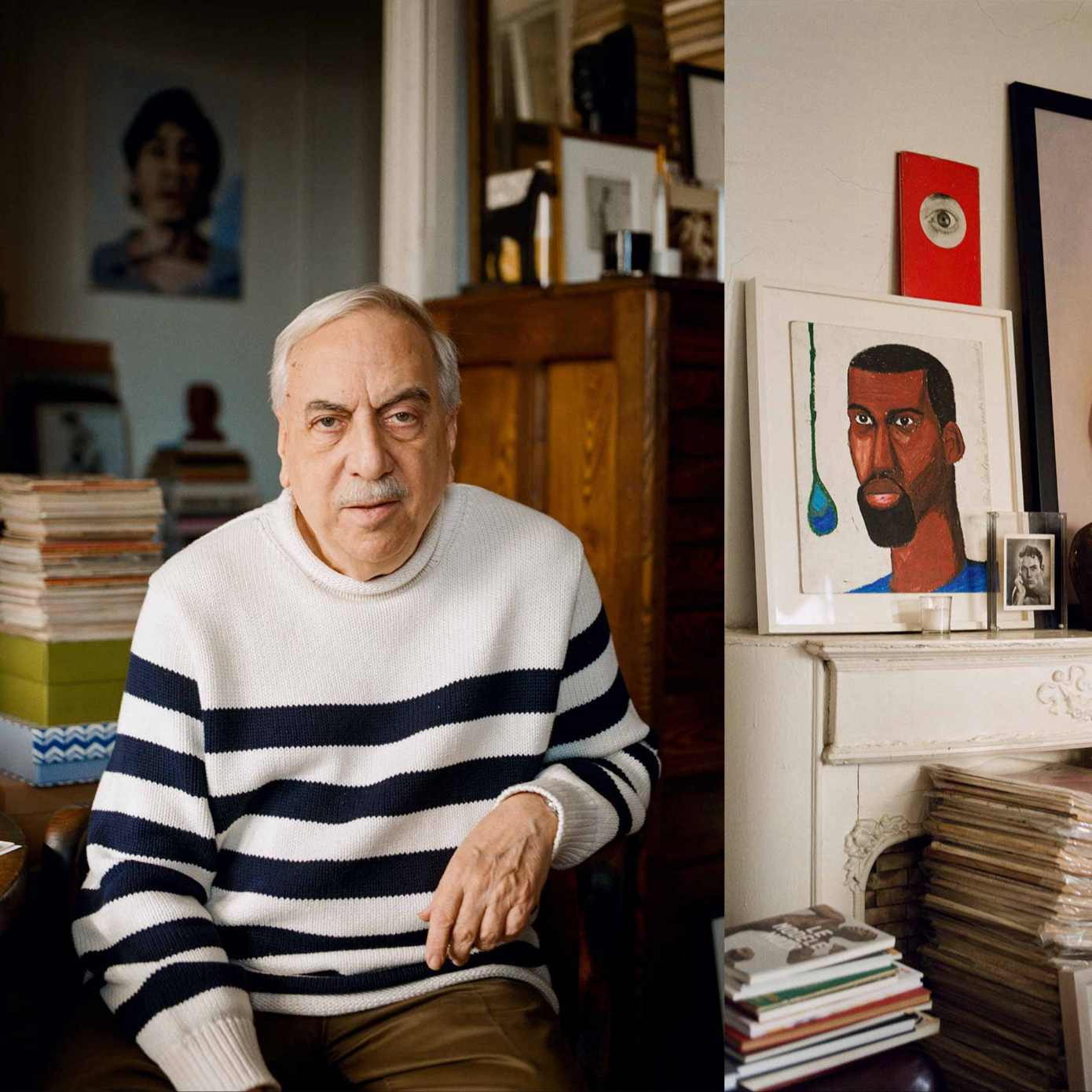
Artist Gisela Colón has strong roots both in Los Angeles, where she’s based, and Puerto Rico, where she is from. However, her organic minimalist monoliths have their own, specific to the location they’re meant for, from London to Egypt. Her most recent piece, Eternity Now, is on view through December for “Forever is Now,” an exhibit by Art d’Egypte at the Pyramids of Giza. Influenced by her fascination with the universe and created with the utmost respect for the planet and the history of each site, Colón’s oeuvre highlights the importance of honoring the past and reminds us to be gentle with our present planet in order to reach the future.
Beatriz Colón: When would you say things first clicked for you as an artist?
Gisela Colón: Well, I was always an artist from the time I was a young child because my mother was a painter. We spent all of my formative years in Puerto Rico, painting oil on canvases. I remember at the age of five or six, I painted these paintings of sugarcane cutting, and still lifes in Puerto Rico, like güiro, maracas, flores tropicales, I mean, all these things that were just part of the culture of Puerto Rico. But it wasn't until a little bit later that I decided, you know, this is really my life's calling and in the mid-2000s, I took it professionally.
BC: What caused the shift for you?
GC: I could pinpoint it to the birth of my sons. There was something biological that clicked when I gave birth to life, the channeling of life through my body really ignited this fire. Creation and the creative process became paramount above anything else. I realized that everything else was just not that important, that I really had to create because the life of a creator is magnificent, when you can wake up every day and your ideas can become reality. It was a magical thing that happened to me.
BC: When do you feel the most creative?
GC: When I'm out in nature, when I'm really in touch with the life force on the planet, like when I'm in Puerto Rico, in El Yunque or on the beach, around that energy.
BC: Were you born in Puerto Rico?
GC: Actually, my birth was in Vancouver, Canada. But I'm not Canadian. My father, who's Puerto Rican, was studying in Canada and married my mother who is Canadian, and then I was born there, but I was taken as a baby to Puerto Rico. I grew up in PR, graduated from the University of Puerto Rico, Recinto de Río Piedras and then I moved to Los Angeles in my twenties.
BC: What are you most excited about lately?
GC: The project at the pyramids of Giza, which is an incredible moment in history, to be a contemporary artist, and to be able to present my work at the UNESCO site. This is a 4,500-year-old historic site, the last extent of the seven wonders of the [ancient] world, and so it's really an honor and a privilege to be able to be in dialogue with this ancient civilization that's one of the most revered and admired on planet Earth.

BC: What connects your recent pieces?
GC: All of my recent pieces are a continuum of my practice of organic minimalism but extrapolated and extended into the natural world. So in the realm of land art, or environmental art, and that movement that emerged in the late 1960s, early '70s, was mostly men, and they were all making very aggressive marks on the land, and utilized hard, geometric forms. So when you're creating land art in the context and the backdrop of that history that is so male-dominated, I see my work as expanding that lineage of the male-dominated field and adding and contributing a new voice that is all about having a feminist approach to the world, a world in which we imbue everything with organic qualities. After all, our planet is called “Mother Earth” for a reason.
BC: If one sees your pieces out of context, they might describe it as a little galactic and metallic. Puerto Rico being so tropical, how has your island background influenced your work in a way that isn't necessarily obvious.
GC: What you touch upon is the story of my life, that of being misunderstood. When I first started painting and showing in the art world, I got this kind of rejection because my work seemed too Latin and had Spanish titles and people didn't understand that. My work has this spirit of Puerto Rico in it, and people miss it because they say, "Oh, it's light and space work," you know, maybe it doesn't have meaning. And it's completely the opposite. I'm adding this whole other layer of conversation to the West Coast minimalist movement because I'm approaching it as a Latin woman in the 21st century, adding all of this organic dialogue that stems from my Latin heritage into the work.
BC: Do your inspirations change from project to project?
GC: Every project is very site-specific. It commands a lot of study of the geology, the history and the cultural past of the place. For London, for example, I did a lot of research on perfecting a surface that could activate in the shade, not the sun. As you know, London is foggy; it's cloudy and gray. So the piece has this pink special pigment that I developed that is dichroic [and] activates in the shade. Then in Egypt, showing work at the pyramids of Giza commanded the utmost respect for the past and the history of that culture so I did a lot of research about aspects of the culture such as astronomy, astrology, sacred geometries.

BC: Tell me about your process from ideation to unveiling.
GC: Well, it starts with the research of the location and then that informs the sculpture. For Egypt, I researched what would be the ideal monolithic form, and I didn't want to compete with them. So I imagine this gold elliptical dome; the surface refers to gold as a precious material in Egypt. I developed this pigment that runs the gamut from rose gold to yellow gold, so as the sun moves around during the day, the piece will shift color. It speaks to how the Egyptians venerated the sun, they would say, "the sun is what gives us life." It's the giver of life. It's structured like the Eye of Ra, which is kind of a dome shaped eye, and the Eye of Horus, which is a magnificent example of elliptical curvature in the vernacular language of Egypt. It also tackles things like ancient Egyptian astronomy; they would study, for example, the position of the stars, and they lined up the pyramids with the stars. So all of that goes into my piece, which really is a symbol of unity, where we cross cultures, we cross boundaries, and I'm hoping that it communicates a feeling of timelessness where we’re all united as one on the planet.
BC: What have you been dreaming of lately?
GC: You know, I was heartbroken when the Observatorio de Arecibo [in Puerto Rico] crashed. I was always so proud as a child that the Observatorio de Arecibo was the number one telescope in the world where you could go to see outer space. And then it crashed and I thought, ‘God, it would be amazing if I could install a monolithic sculpture in the vicinity of the Observatorio, as a memory, a sense of respect for the legacy of what [it] stood for the Puerto Rican people and for the world.’ So that's something I'm dreaming of, and maybe it'll become reality.
BC: What is the future of land art?
GC: I think land art should really focus on healing the planet and making work that if it is removed, leaves no trace, and I'm proud that my work is made from carbon fiber and these pieces are made of the most elemental material of the Earth.
BC: Where are they brought to life?
GC: In Southern California, I work with an aerospace company that is Latin-owned and I have an amazing team of technicians that I’ve worked with now for six years.
BC: When you think about legacy, what do you feel or imagine?
GC: People connecting through my work because the way I see it, I really try to rise above the Earth a lot of times and view us from way above. I see us all as one human people on this little blue ball floating through space. I want to create this awareness of where we are and how important it is to become united because all we have is ourselves and this planet.
Craving more culture? Sign up to receive the Cultured newsletter, a biweekly guide to what’s new and what’s next in art, architecture, design and more.



